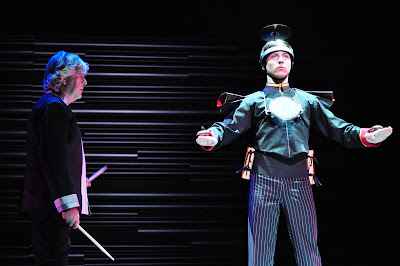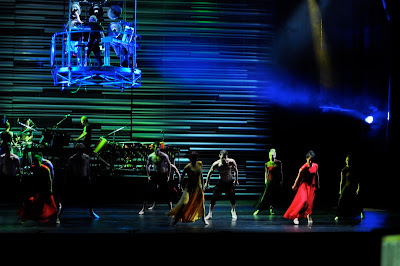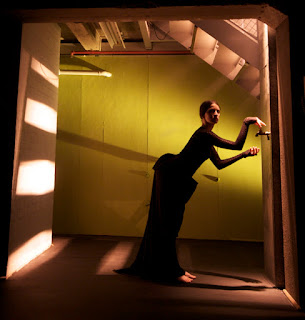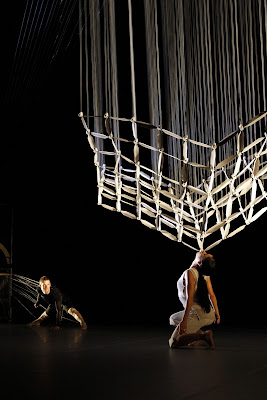The launch of Mod Dance Company has generated a fair amount of buzz in the dance world and its opening night was a glitzy affair with dance industry people aplenty peppering the audience. It’s a new dance company with an unabashedly commercial contemporary edge and artistic directed by Brett Morgan, a veteran of Sydney Dance Company. Several of the 19-large ensemble have worked in Sydney Dance Company (when it was still under Graeme Murphy’s direction). Others come from musical theatre and commercial dance backgrounds and there's even a So You Think You Can Dance Australia finalist ( Henry Byalikov - he was season one's long-haired ballroom dancer.)
With Morgan at the helm, associate director Teagan Lowe also an ex-Sydney Dance Company dancer and Graeme Murphy as the artistic patron of the company, it’s not a surprise that MDC launched themselves to Australia with a Graeme Murphy offering. Strategically, it’s a smart move since Murphy’s extensive body of work is adored by a wide-range of dance fans and he has huge name recognition. He's probably this country’s most prolific choreographer.
MDC’s debut offering called Suite Synergy is a remixing of Murphy’s Synergy with Synergy (1991) and Free Radicals (1996.) These works were seminal for their collaboration with Australian percussionist Michael Askill (who appears in the work alongside 3 other musicians) and were quite cutting-edge for their time. Looking at them now in 2011, a lot of great elements remain - some explosive ensemble work, campy humour and interplay with dancers and musicians. With the exception of some costumes and a lacklustre flamenco-inspired tap number and a pointe ballet section, the works do not look that dated.
Murphy's choreography mixes large rhythmic group dancing with more (dare I say) gimmicky sections - a woman (Emee Dillon) dances with three bouncing lights that tickle and jump around her body; a man (Kalman Warhaft) has a slapstick routine in which everything he touches sticks to himself, resulting in some knotted-up choreography. There's a duet where Askill plays dancer Rhys Kosakowski like a drum kit (see photo below). A lot of audiences will find this character-based material a little forced and rather silly, but it's important to remember that Murphy originally made this material on and for dancers that that he had worked with for years and drew inspiration from particular individuals. Seeing Suite Synergy now, those original personalities aren't there anymore and the new dancers don't yet quite know how to truly make that material their own.
 |
| Michael Askill and Rhys Kosakowski. Photo by Michelle Grace Hunder. |
The ensemble choreography is full of jumping, turning, contraction-based action - it’s powerful, explosive movement that engages the whole body. There is lots of "signature Murphy" - a woman walking atop the backs of men like she is climbing a staircase, luscious linear pattens that travel in swirls and arabesque lines that punctuate jumping phrases. It’s the kind of energetic and athletic dance that, when well-performed, can shower exhilaration on the audience and it’s easy to see why these were such crowd-pleasing works in their day. (Synergy with Synergy and Free Radicals are some of Murphy’s most commercially successful and popular pieces.)
Of course, back in the 1990s when the works were made the percussion element was a huge part of their popularity. When Murphy had Askill and his crew get on stage with the dancers in duets of body percussion the world was only beginning to know about shows like Stomp and Tap Dogs. Now percussion as physical performance is its own well-worn genre, and while the percussion/dance relationship doesn't stand out as particularly exceptional in Suite Synergy, it's a still a major part of the work. There are exceptional moments - the initial image of the percussionists suspended on a platform above the stage (see photo below) and a section of simultaneous duets where the percussionists slap and tap out rhythms using the dancers' floppy, relaxed bodies.
 |
| MDC ensemble in Suite Synergy. Photo by Michelle Grace Hunder. |
Some of the critical word around Suite Synergy's Melbourne (and world) premiere has been that the content looks dated, it is not Murphy's best choreography and the dancers aren't up to the rigours of the physically demanding neo-classical work. There are elements of truth to these objections, but we have to remember that this is a brand spankin' new company taking a huge financial and artistic risk. It was a smart move to stick with Murphy, a necessarily cautious choice. And this large group of dancers has never worked together before. Many of them are not trained in the modern/contemporary dance techniques at the heart of Murphy's work - some weren't even born when Murphy made Synergy with Synergy.
With more mentorship from Morgan, Lowe and the MDC crew that know Murphy well, the younger dancers can grow into the material and make it their own. Creating a more technically unified ensemble, instilling a distinct MDC stamp on this new company of dancers and building on the individual talents at hand will be crucial to MDC's success. As it is only in its newborn stage, the MDC identity and home style has yet to develop.
If its programming continues in the direction of accessible, crowd-pleasers like Suite Synergy danced by confident, technically-extraordinary performers, it will earn Australian audiences. There are probably big markets for MDC to tap overseas, especially in Asia where Murphy already has superstar status (as much as a contemporary choreographer can have such a thing.)
Importantly, MDC is a unique model in this country. It is fully-funded through private money (unless you count the fact that the original dances were made when Murphy worked for a government-supported SDC). While this model is modus operandi in the United States, it is nearly unheard of in Australia. MDC is under the auspices and infra-structure of the well-established Mod Talent Agency and has four company directors. This corporate model creates much more freedom and flexibility for MDC than relying on the slow and fickle government funding route to establish and then maintain a new company. (On a smaller, local scale, the Melbourne Ballet Company has also established themselves on this model and has presented eight seasons in three years.)
It’s early days for MDC and it will be interesting to see in what artistic direction it will wander. Will it stay closely aligned to its artistic patron and retain a Murphy sensibility or will it develop a new ethos? Only time will tell, but congratulations to MDC for realising such a large-scale vision so quickly and even better, giving a promising bunch of professional dancers the chance to both grow as artists and work at an exciting venture.
Click here for my brief review of Suite Synergy in the Herald Sun, 25 March 2011.
Suite Synergy by MOD Dance Company
State Theatre, the Arts Centre
23 - 26 March 2011
Touring nationally













